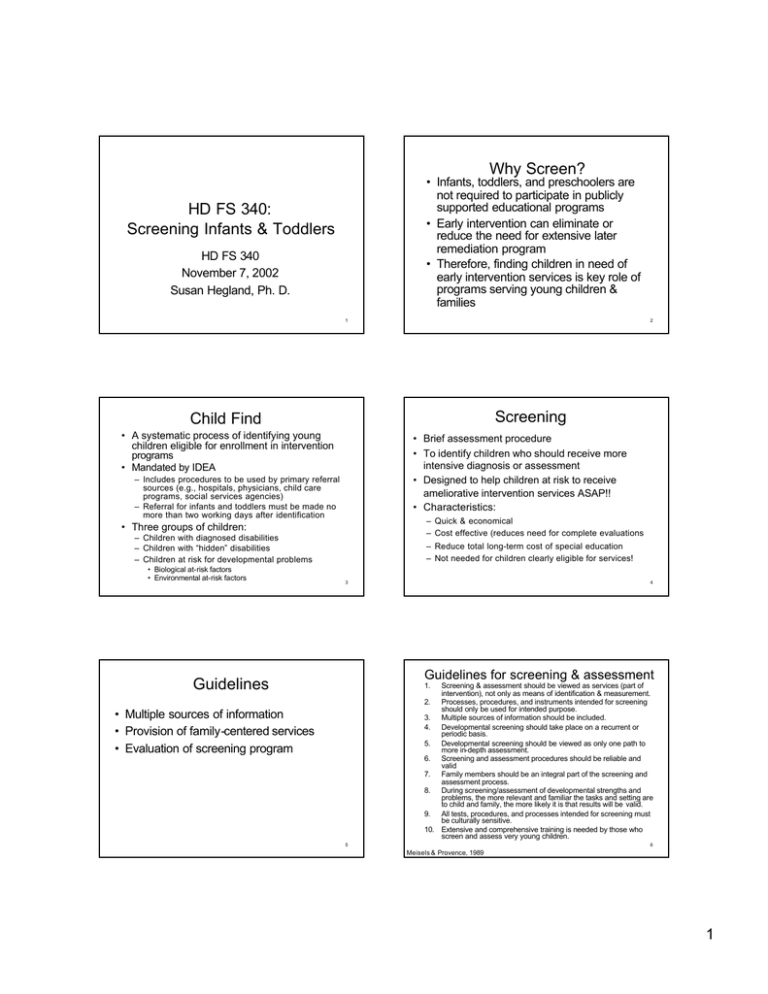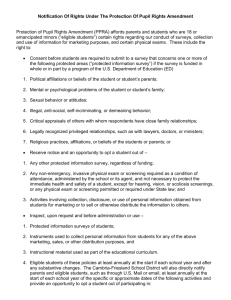Why Screen? HD FS 340:
advertisement

Why Screen? • Infants, toddlers, and preschoolers are not required to participate in publicly supported educational programs • Early intervention can eliminate or reduce the need for extensive later remediation program • Therefore, finding children in need of early intervention services is key role of programs serving young children & families HD FS 340: Screening Infants & Toddlers HD FS 340 November 7, 2002 Susan Hegland, Ph. D. 1 2 Screening Child Find • A systematic process of identifying young children eligible for enrollment in intervention programs • Mandated by IDEA • Brief assessment procedure • To identify children who should receive more intensive diagnosis or assessment • Designed to help children at risk to receive ameliorative intervention services ASAP!! • Characteristics: – Includes procedures to be used by primary referral sources (e.g., hospitals, physicians, child care programs, social services agencies) – Referral for infants and toddlers must be made no more than two working days after identification – Quick & economical – Cost effective (reduces need for complete evaluations • Three groups of children: – Children with diagnosed disabilities – Children with “hidden” disabilities – Children at risk for developmental problems • Biological at-risk factors • Environmental at-risk factors – Reduce total long-term cost of special education – Not needed for children clearly eligible for services! 3 4 Guidelines for screening & assessment Guidelines 1. Screening & assessment should be viewed as services (part of intervention), not only as means of identification & measurement. Processes, procedures, and instruments intended for screening should only be used for intended purpose. 3. Multiple sources of information should be included. 4. Developmental screening should take place on a recurrent or periodic basis. 5. Developmental screening should be viewed as only one path to more in-depth assessment. 6. Screening and assessment procedures should be reliable and valid 7. Family members should be an integral part of the screening and assessment process. 8. During screening/assessment of developmental strengths and problems, the more relevant and familiar the tasks and setting are to child and family, the more likely it is that results will be valid. 9. All tests, procedures, and processes intended for screening must be culturally sensitive. 10. Extensive and comprehensive training is needed by those who screen and assess very young children. 2. • Multiple sources of information • Provision of family-centered services • Evaluation of screening program 5 6 Meisels & Provence, 1989 1 Family Centered Multiple sources • • • • Family centered practice is beneficial and desirable: • Both legally and practically! • Parents must be empowered to feel and be responsible as “child’s first teacher” • When family members are present and feel supported, more likely to stay involved in planning, implementation, and evaluation • Parents need to be Developmental measures Sensory (vision, hearing) Health Adding environmental & caregiving factors increased accuracy – Screening tool(s) – Parent questionnaire – – – – – Informed about screening process Purpose and potential outcomes Qualifications of persons involved Given option of participating Given results of screening immediately • In jargon-free terminology 7 8 Evaluation of screening program Selecting Screening Instruments • Did some children “pass” the screening but later required special education services? • Were some children referred for evaluation who were found not to need special services? • Were families involved satisfied with experience? • Is evaluation completed in a timely manner? • • • • • • • Criteria Brief Norm-referenced Inexpensive Standardized in administration Objectively scored Broadly focused across all areas of development (motor, language, cognitive, social, emotional) • Sensitive to sample of children developmentally at risk • Specific to the portion of children who are not at risk 9 10 Potential Outcomes from Screening Reliable and Valid • Reliability Referred for diagnostic assessment – Consistency – Stable • Validity (accuracy) Not referred for diagnostic assessment – Concurrent validity Eligible for Special Services • Scores correlated with more thorough, diagnostic tests – Predictive validity • Scores correlated with children’s performance on outcome measures later in time False Negative • Norm-referenced – Standardization sample includes this child’s racial, linguistic, economic, geographic background. – Free from bias due to sex, geography, economic background, culture, ethnicity, race 11 Not Eligible for Special Services False Positive 12 2 Sensitivity and Specificity High Sensitivity, High Specificity • Sensitivity – Ability of test to identify a high proportion of the children wi th developmental delays (disabilities) Referred for diagnostic assessment Not referred for diagnostic assessment Eligible for Special Services High Low Not Eligible for Special Services Low High • Specificity – Ability of the test to NOT identify children who do NOT have a disability or developmental delays • Goal – high sensitivity and high specificity! • High in sensitivity, low in specificity: – Identify children who need services – waste diagnostic funds assessing too many kids – Unnecessarily worry parents • Low in sensitivity, high in specificity: – Delay services for children who need them – Increase costs and decreasing impact of remediation services 13 High Sensitivity, Low Specificity Referred for diagnostic assessment Not referred for diagnostic assessment Eligible for Special Services High Low Not Eligible for Special Services High 14 Low Sensitivity, High Specificity Referred for diagnostic assessment Not referred for diagnostic assessment Eligible for Special Services Low High Not Eligible for Special Services Low High Low 15 ASQ (Ages & Stages Questionnaires: A Parent-Completed, Child Monitoring System) • Standardization Sample 16 ASQ Description Areas: – 2008 children (53% males; 65% Caucasian) – Families – Communication – Gross motor – Fine motor – Problem solving – Personal-Social • income from < $5000 (13%) to more than $40,000 (2.3%) • Education from <7th grade (1.6%) to post-grad (6.8%) – Age range from 4 to 36 months – Children were full term (>37 weeks) • Reliability: – Internal consistency from .54 to .83 – Test-retest: 94% agreement across 2 weeks Age levels: • Validity (concurrent, with Bayley , Stanford-Binet) – 4, 5, 8, 10, 12, 14, 16, 18, 20, 22, 24, 27, 30, 33, 36, 42, 48, 54, 60 months – Sensitivity: 72% – Specificity: 86% 17 18 3 Explaining screening/monitoring process Possible method of use 1. • On-site (by parent and/or professional) – Child care center – Parent education/support program 2. – Homeless shelter – Health clinic 3. 4. • Home visit (by parent and home visitor) • Mail out – Danger: discriminates against parents with limited reading skills 5. Written parent consent required for each!! 6. 19 Explain that child must be n rested, n fed, and n ready to play Explain questionnaires designed to determine what child can and cannot do. Be sure they understand that the child will probably NOT be able to do all the activities targeted. Emphasize importance of trying each activity with the child Many questions have 3 possible answers: n Yes (child is doing activity now) n Sometimes (child just beginning to do activity) n Not yet (child has not yet started to do activity) Clarify how to answer questions about activities child did earlier but no longer does, or does infrequently (e.g., crawling = yes) Emphasize name of contact person, name & address & phone number of program 20 Refer/follow up criteria • Refer child – whose score in one or more areas is below established cutoff point (2 standard deviations below mean) • Follow up with child – whose score in a particular area is close to cutoff score • Follow up with child – whose scores are above cutoff points for each area, but whose parent has indicated a concern in the Overall section. 21 4


